Modern edging ideas: 11 chic ways to divide your garden zones
Try these modern edging ideas to bring order to your lawn, flowerbed or path – they're the perfect finishing touch
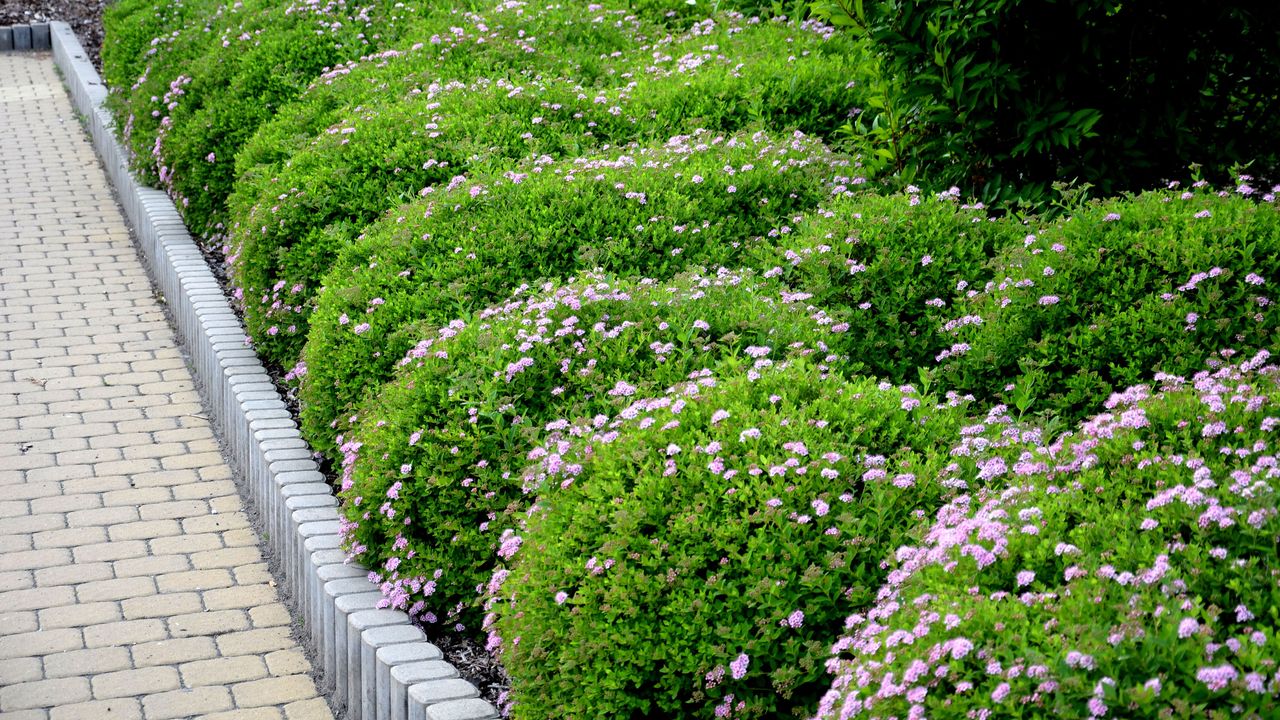

For modern edging ideas with style and substance, look no further. From contemporary stone, hedges, or even timber, these tips and materials will make your plot look shipshape in no time.
But what exactly is edging? Think of it as bordering off sections of your garden, adding order, if you will. Not only does it help your plot look neat and tidy, but it also makes maintenance easier. It keeps gravel, mulch, and other garden materials in their proper place. Plus, installing a flat strip of edging around a lawn will make mowing quicker and easier, as you won’t be worrying about mowing over precious plants!
Edging is super versatile too – it can be made of almost anything, really. We’ve seen shells, tiles, even recycled bottles being used for the job. For crisp lines and a modern vibe, however, we’ve picked out our favourites. So keep scrolling to see more options to try in your space.
And, if all this talk of edging has got you thinking about other updates too, check out our modern garden ideas for an extra dose of inspiration.
1. Go sleek with stone
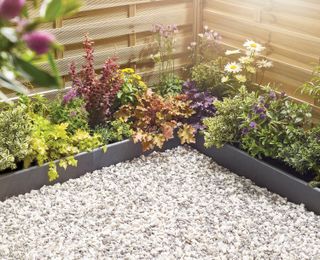
Natural Stone Bull Nose Edging Ebony from Homebase
A natural stone edging in a polished finish will add a sophisticated touch to your borders. Just an inch or two in height is all you need to frame your flowers and foliage, plus it keeps the dark hue from feeling overwhelming.
It's a lovely contrast against the soft planting and the lighter coloured gravel. A great choice for small, modern plots.
2. Use contrasting tones for a statement feature
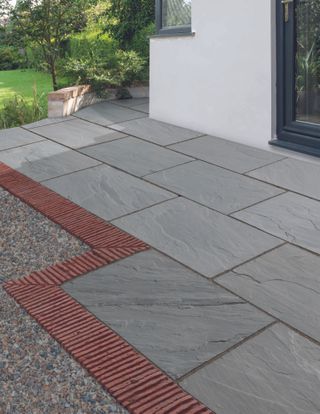
Tile on Edge edging from Bradstone
These smart edging tiles are cleverly made to look like brick tiles stacked on their edges, offering a rustic, reclaimed look without the fuss. They're ideal for patio ideas as they look great between paving and gravel, adding a contrasting splash of colour to the mix.
'The most important thing to make edging really effective is to ensure it is different to your patio – either in style or colour,' says Lee Dunderdale, Product Manager at Bradstone.
This product above offers a modern twist on a traditional look. 'I would always recommend opting for the colour which contrasts most with your paving to create distinction and definition in the area you are edging,' he adds. 'For example, if you are using edging against a grey patio, you could opt for terracotta tones, or if installing natural stone paving with yellow or brown tones, round it off with anthracite coloured edging.'
3. Get creative with shapes using recycled rubber
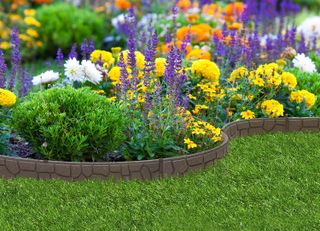
Ez Border Garder Border - Stones Earth from Homebase
If kids or pets are frequent visitors to your garden, then perhaps consider a softer edging for your plot. This one is made from rubber, meaning it's durable without any sharp corners.
What's more, it's super flexible, meaning you can easily install it around curved borders or paths. No need to feel restricted by square shapes and lines – get creative!
Made from recycled tyres, it's eco-friendly too. Plus, the pattern will add a fun and funky feel to a family garden, without it dominating the space.
4. Use bricks to create a mowing strip
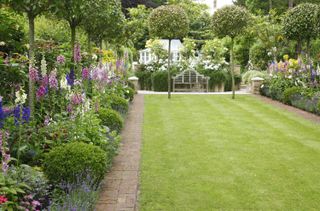
Traditional bricks are a timeless look when edging a lawn
We've mentioned mowing strips and how useful they are, but this example shows they're not just for practical use – they're a stylish feature too.
Red bricks may be a classic material but they work brilliantly in more modern styles of garden too thanks to their timeless looks. Arranged into a neat pattern, they keep the lawn in order and the vibrant plants contained in the flowerbed. Allow moss to grow between the gaps to soften the look for a more natural, secret-garden feel.
We love how this look ties into the stone garden wall ideas too, helping to bring the space together beautifully.
5. Embrace natural textures
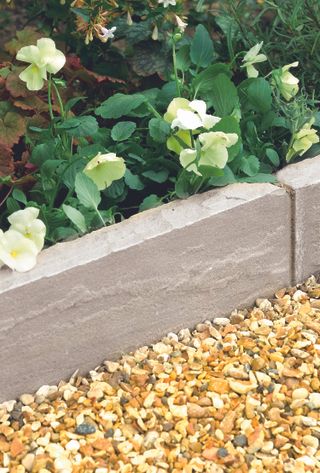
Natural Sandstone Edging from Bradstone
Sometimes, all you need is the simple colours and textures of nature to elevate a space. For instance, an unpolished sandstone will add a stunning yet pared-back vibe to your borders and paths.
Its riven finish reflects the stone's natural origin beautifully, adding subtle textural interest and a contemporary feel. And, if you think grey is boring, think again – it's the perfect accompaniment to vivd planting and is on trend right now (check out our garden trends to see for yourself).
6. Play with shapes for added interest
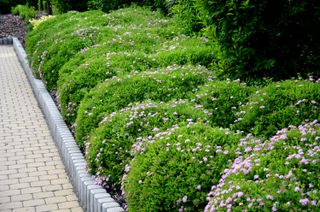
Using a variety of shapes adds fun and form to a garden
Edging can provide an opportunity to introduce new shapes and forms to your space.
Here, this moulded concrete border offers a pleasing contrast against the soft, spherical mounds of the plants above. It's the perfect mid-point between the smaller, staggered pavers on the ground, and ties the whole look together stylishly and seamlessly.
Head over to our guide to garden borders for more planting inspiration.
7. Go natural with wood
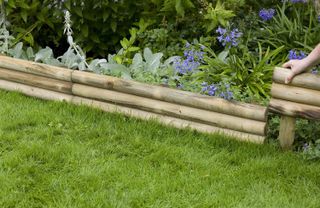
Horizontal Log Edging from Homebase
Want to add a twist of alpine-chic to your plot? Try adding an edging made from horizontal, half-round logs, reminiscent of cosy cabins and pine forests.
Their elongated lines will make your flowerbeds seem wider. Plus, these ones are styled in rows of three – which is super pleasing to the eye. A beautiful divider between your lawn and plants.
8. Surround your seating to zone spaces
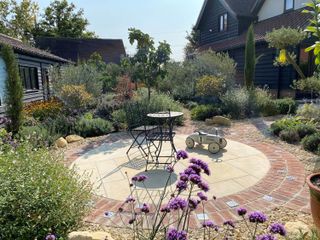
Use edging to create a central seating area. Garden designed by Oliver Bond at Bond Landscape Design
Edging isn't just for lawns and flowerbeds. You can also create a border for a seating area to make it a real focal point for your garden.
This example created by Bond Landscape Design surrounds a spherical patch of light-coloured paving with a border of red bricks and blue-patterned tiles, which then blends into the surrounding pathways.
A fine layer of sandstone-coloured gravel around the outer edge completes the look and keeps the luscious planting neatly in place.
9. Go timeless with a miniature hedge
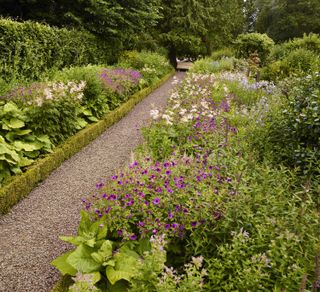
A classic box hedge is a softer way to divide the space
Sometimes the best way to separate your flowers from your path, or your patio from your lawn, is with a low-growing hedge. It's simple but effective and looks especially striking when freshly clipped.
Dwarf box is a great go-to option, try the 'Suffruticosa' for evergreen leaves and a compact shape. Alternatively, try box-leaved holly, or even 'Dwarf Munstead' Lavender with its relaxing fragrance.
Take a look at our guide to the best fast growing hedges if you want to add a new hedge to your plot.
10. Give your small beds a border
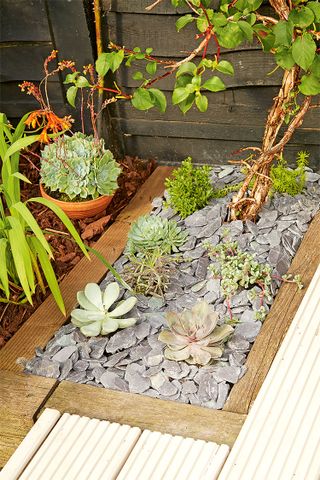
Make even the smallest bed a feature with edging
You don't need to have a huge flowerbed or spacious seating area to add edging to your plot. Even for the smallest of beds, such as this tiny gravel garden, a border of edging will give it the attention it deserves.
This wooden border creates a distinct look between the decking and bark chips, breaking up the space into orderly forms. It's the perfect way to frame the light grey stone and succulents.
11. Use weathered steel for a contemporary look
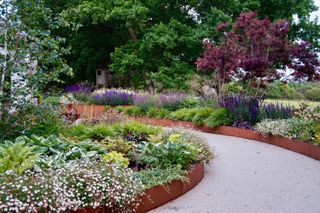
Weathered steel edging created by Outdoor Design looks stunning in this garden designed by Your Garden Design
We love the striking effect weathered steel gives to a garden. Otherwise known as Corten Steel, it develops a layer of warm-hued rust which, believe it or not, actually protects the metal within from breaking down.
It provides a great urban look and looks stunning amongst large borders with its copper colouring.
What is the best material to use for garden edging?
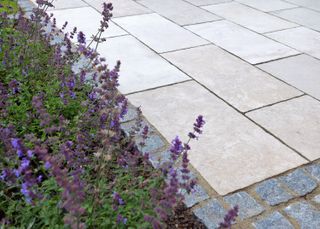
Go for stone edging if durability is what you're after
If you're looking for durability, then stone or concrete is the best material to use for your garden edging.
Lee Dunderdale, Product Manager at Bradstone, gives his advice. 'Edging comes in a number of materials, including plastic, wood and stone. Plastic is a cheaper alternative and can sometimes look unsightly against a well-designed garden, and wood can rot or warp once weathered.'
'However, concrete or natural stone edging is not only stylish and versatile, but also durable and will stand the test of time, making it worth the investment.'
As we've mentioned, weathered steel is a good, hardy alternative for a different look.
Is edging your garden hard?
Edging your garden doesn't have to be hard! But it all depends on what type you're going for. If, for instance, you're edging a ready-made flower bed something like a log-effect or rubber strip with pre-attached spikes, you can simply tap it into the ground using a wooden block and a mallet.
On the other hand, if you're looking to install a stone border, then there's a bit more work involved – namely digging a trench, and ideally, laying a concrete foundation.
With metal edging you'll need to do the same, but you can skip the concrete, as long as it's firmed in properly with soil.
Of course, if your bed or patio isn't built yet, you'll also have to get this sorted too. We can help you get started on that with our guide on how to lay a patio.
Read more:
- Modern paving ideas: contemporary looks for your space
- The best edging plants: soften your landscaping with these top picks
- Garden path ideas: creative ways to get from A to B

The garden was always a big part of Holly's life growing up, as was the surrounding New Forest where she lived. Her appreciation for the great outdoors has only grown since then. She's been an allotment keeper, a professional gardener, and a botanical illustrator – plants are her passion.
-
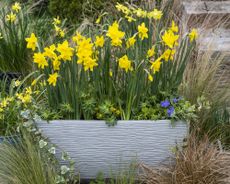 An Update on Gardeningetc
An Update on GardeningetcA word from our publisher
By Beth Murton Published
-
 Do you need to chit potatoes? Find out what the experts say
Do you need to chit potatoes? Find out what the experts sayGrow Your Own Learn how to chit potatoes before planting them in the ground and you’ll be on your way to getting an earlier and bigger harvest
By Drew Swainston Published
